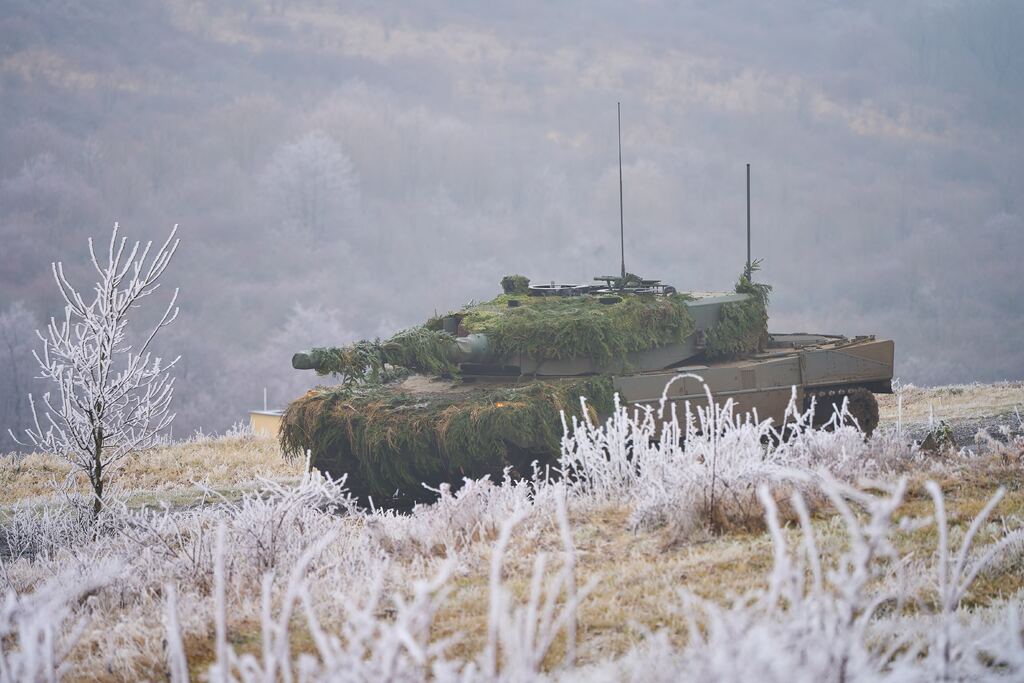Compared to the T-72, it is easier to handle, more comfortable and there is a diametric difference in the technological equipment. This is how the users themselves evaluate the new Leopard 2A4 tanks. These days, ten of these machines are undergoing their first major stress test at the Hradiště military base since the start of the rearmament. More than 300 soldiers from the 73rd Tank Battalion and the 7th Mechanised Brigade are taking part in the two-week Tasmanian Lizard exercise. Lieutenant General Karel Rehka, Chief of the General Staff of the Czech Army, also visited them.
Tanks, BVP-2s, Tatras and other vehicles had to move to the Doupovské hory first. Wheeled vehicles travelled 400 kilometres on roads, while tracked vehicles travelled by rail. It was the first time for the Leopards, but mainly for the logistics of the Přáslavice unit. "They weigh 60 tonnes each and are loaded onto special railway wagons. Transportation on Leopards requires not only having the equipment perfectly prepared, but also planning the route carefully," explains the commander of the unit, Lieutenant Colonel Tomas Suchy.
Along with the equipment, those without whom training on such a scale would not have been possible - workshop workers, medics or cooks - travelled to West Bohemia. "The gradual movement of equipment and personnel took place until late in the evening of 2 December. During this time, all equipment underwent basic maintenance and refuelling to be ready for immediate deployment the following day," the commander described the preparations.

Sharp shooting day and night
The Tasmanian Lizard, which ends on Saturday, is the first time since its entry into service that all the capabilities of not only the new tanks, but also the soldiers who have been retrained on Leopards under the supervision of German instructors since 2023, have been tested.
"This is a comprehensive training of the entire 73rd Tank Battalion. The main objective is to test the synergy of all components - from tank crews to logistics to medical teams." says the commander.
The 73rd Tank Battalion in Práslavice currently has 14 vehicles in its armament, and the remaining 14 units should be taken over by the end of 2025 from Germany, which donated them to the Czech Republic in exchange for aid to Ukraine. The contract for the other 14 Leopard 2A4 battle tanks was signed by the Minister of Defence at the end of November. In total, the Czech Army will have 42 Leopard 2A4 tanks and two Büffel 3 recovery vehicles.
Thus, mechanics take care of the equipment during the exercise, logistics teams provide fuel and supplies, medics would take care of the wounded in a real deployment, and of course the main actors are not missing - tankers. All this in a scenario that simulates as closely as possible the conditions of modern conflicts.
"Combat conditions are changing rapidly today, it is no longer the traditional clash of armies in the open field. Soldiers are therefore confronted with a wide range of unexpected situations, from defensive actions to complex offensive operations, day and night. They must negotiate unfamiliar terrain, coordinating their actions with each other," says Lieutenant Colonel Suchý.
The training, he said, focuses not only on mastering the correct control of the new technique, but also on teamwork and improvisation. "They need to be able to react quickly, make decisions under pressure and work as a team. The Tasmanian Lizard is such a unique opportunity to combine advanced technology with thoroughly trained soldiers."

Better in every way
For Leopard crews, the Tasmanian Lizard is a real challenge, testing everything tankers need to master in modern combat operations - from defence and attack, to live fire, movement and camouflage, to night operations.
"The Leopard handles very differently than the T-72," recounts his first impressions from a combat training deployment Miroslav Cerny. "It has an automatic gearbox and a much better chassis, so it's more stable and more controllable even on difficult terrain. The ride is smoother, you don't feel every rock like in older tanks," he says. In addition, the Leopard has advanced navigation and tracking systems that let us know exactly where we are and where to go. That wasn't in the T-72 at all." praises the German heavy battle tank.
According to the commander, Lieutenant Colonel Tomáš Suchý, the modern equipment not only facilitates navigation even in unfamiliar terrain, but also significantly increases the combat effectiveness of the crew - the ability to quickly and accurately determine the position of the tank is crucial for successful mission execution. "A smoother ride and better handling also significantly improve the tanker's work. In the T-72, they had to constantly struggle with the difficult controls and thus tired more quickly. In the Leopard, on the other hand, they can spend more time on the operation itself and less time focusing on vehicle handling." highlights the benefits of the new machines, which will be participating in NATO international exercises in Poland and Germany next year.
ACR/ gnews - RoZ



